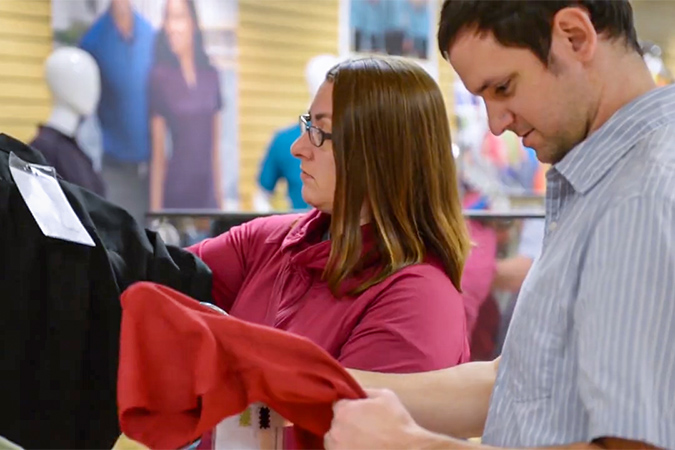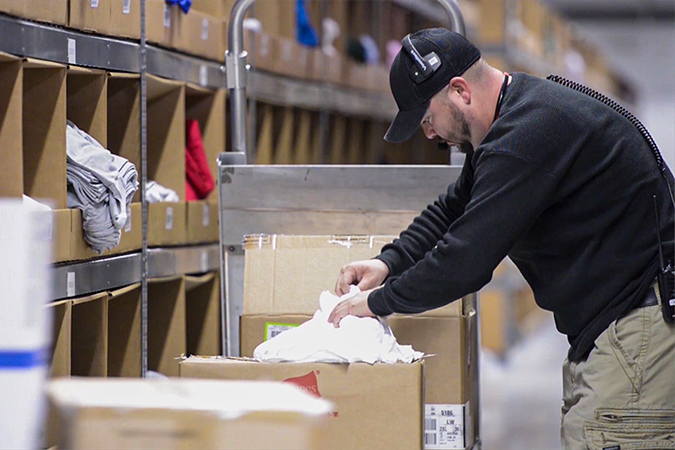Sports fans: Did you know the journey of your team apparel may start on rail?

BNSF customers use rail to ship all sorts of things, even your favorite game day jersey. From professional baseball to your local softball team, college to pee wee football, no matter your favorite sport or team, BNSF works with companies like SanMar, one of the nation’s leading suppliers of apparel in wholesale distribution, so fans worldwide can proudly display their team spirit.
SanMar is the company you may have never heard of, but you probably have a product or two of theirs in your closet. The maker of t-shirts, polos, ball caps, bags and more, SanMar’s products show up wherever custom apparel and accessories are needed. (Their gear is purchased by promotional companies and decorators that then apply a team or corporate logo.)
Given how fanatical sports enthusiasts can be, it’s not unusual for SanMar to get large orders with a short turnaround. “One of our pro teams was looking for 25,000 shirts for a game, and we were able to deliver in a week’s notice,” said John Janson, SanMar’s director of Global Logistics and Transportation.

That’s just one example of the company’s customer service -- and that’s not reserved just for companies servicing professional teams. SanMar’s biggest base is some 75,000 small and medium customers that in turn service millions of customers.
To meet all of its customers’ delivery needs, SanMar relies on transportation partners like BNSF to get shipments to and from its eight distribution centers (DCs). BNSF’s intermodal trains, loaded with shipping containers and trailers, move from a port or intermodal terminal, for example our Los Angeles facility, to an inland hub, such as Chicago. From there, truckers move the product to final destination. Multiple companies working together is why it’s called intermodal – or multi-modal – service. With this service, customers’ goods – furniture, clothing, electronics, appliances -- can safely and securely move in the same box for the entire trip.
Last year, this business (what we call Consumer Products) made up more than half of our volumes – about 5.6 million loads, making BNSF an intermodal leader, serving 40-plus ports -- where international containers come in from and go out -- plus 25 domestic intermodal facilities, where the domestic containers are brought in and sorted onto trains. Once on our intermodal trains, those loads can average up to 800 miles a day.
Businesses like SanMar turn to intermodal for a variety of reasons. They may want a sustainable solution, one where a single double-stack train takes several hundred long-haul trucks off the nation’s busy interstates and significantly decreases their carbon footprint. They may want an alternative to all-truck, which can be costlier. They may be looking for a range of services, including expedited service or temperature-controlled capabilities.

To help businesses better understand intermodal and the value it offers, BNSF has an Intermodal Solutions Team (IST) of about a dozen people strategically positioned around the U.S. and Mexico. When they engage with a customer for the first time, the team will present a customized report using a BNSF tool called “Intermodal Advisor” to help identify potential over-the-road (all-truck) shipments that could be converted to intermodal.
“We use the tool to show both new and existing customers how intermodal fits into their supply chain model,” said David Clark, West director, for the BNSF IST. “Their business models are constantly changing, and as they do, intermodal may be a better solution.”
These customers are called beneficial cargo owners, companies that import products, many of which are “big box” retailers.

“Our job is to not only educate, but to influence the transportation decision-making for beneficial cargo owners toward more use of BNSF’s intermodal service,” explained Gregg Zody, general director for the team. “Often we have to explain what the railroad isn’t. We may be 170 years old, but we’re not slow. We have technologies, including custom apps, that help us stay ahead of the needs of today’s mobile, point-and-click economy.”
Importantly, this team helps to build relationships and trust. “When we engage with the customers, it’s a win-win for both,” said Taylor Harrington, East director. “We learn about their business, even to help influence where they locate their DCs. Then, using our Advisor tool, they find out how intermodal offers savings, reduces carbon and improves their efficiency.”
But when SanMar’s Janson was asked to meet with IST’s Jace Thompson, his first thought was, “Why do I need to meet with BNSF and what can they do for me?” In late 2018, when the West Coast became backed up with loads with nowhere to go, Janson got his answer when Thompson advised him on how and where to move in certain lanes.

“Being able to get that advice and industry knowledge was absolutely critical,” Janson recalled, and aligns with his company’s business values: Do the right thing, treat other people fairly and business partners are built on long-term relationships.
“The BNSF team was able to escalate our issue with some of the service providers [truck partners] to make sure that we were moving product, had the right equipment on-site and were working with the right partners to move product to the right destination.…It was huge to us. We ended up pretty much unscathed through the busy season in 2018.”
Note: If your business would like to develop an effective logistics strategy that involves intermodal, reach out to BNSF’s intermodal solutions team.
Learn more about SanMar’s Canvas for Good
Some might say a t-shirt is just that: a t-shirt. But at SanMar, a t-shirt is a canvas for good. Through responsible practices, the company creates a shirt that shapes teams, builds connections and unites communities. To learn more, visit the website and read the stories about the company, its people, products and practices.